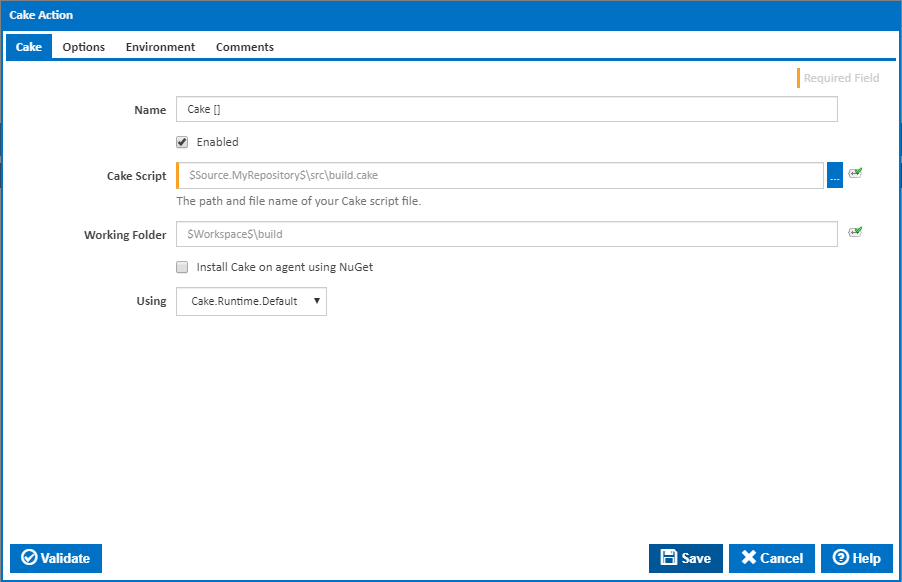Cake Action
The Cake action in Continua is a wrapper around the cake.exe command line. If you're having trouble using the Cake action, please refer to the Command Line Reference.
Cake (C# Make) can be used to run various build tools defined in a C# DSL script. This action runs the Cake command-line. For more information about the project and documentation on the command-line arguments, please visit the Cake website.
Cake

Name
A friendly name for this action (will be displayed in the actions workflow area).
Enabled
Determines if this action will be run within the relevant stage.
Cake Script
The path and name of the Cake script file to be used.
Working Folder
The working folder (relative to the build workspace). Optional. If not specified, then the build workspace folder is used.
Install Cake on agent using NuGet
Optionally run NuGet to install Cake to the agent before running the action. When this is ticked an input box appears to enter the installation location and a new tab appears for entering NuGet settings.
Install Cake To
Shown when "Install Cake on agent using NuGet" is ticked. Enter the path to a target folder for the NuGet installation. This will generally be a subfolder of the build workspace.
Using
The Using drop down is populated by any property collector properties whose namespace matches the pattern defined by the Cake action. The pattern for this action is ^Cake\..*. The default property collector searches the environment path for "cake.exe".
If you create a property collector for this action, make sure you select the Path Finder PlugIn type and give it a name that will match the pattern above in blue. Example names listed here, search the table's Plugin column for "Cake".
For more in-depth explanations on property collectors see Property Collectors.
Alternatively, you can select the Custom option from the Using drop down list and specify a path in the resulting input field that will be displayed. Please read Why it's a good idea to use a property collector before using this option.
NuGet

Sources
A list of package sources to install the Cake package from. Optional. You can separate multiple sources with semi-colons.
Install prerelease packages
Optionally install pre-release versions of the Cake package.
Use cache
Optionally attempt to source the Cake package from the NuGet machine cache.
Using NuGet
The Using drop down is populated by any property collector properties whose namespace matches the pattern defined by the NuGet action. The pattern for this action is ^NuGet\..*. The default property collector searches the environment path for "NuGet.exe".
If you create a property collector for this pre-install action, make sure you select the Path Finder PlugIn type and give it a name that will match the pattern above in blue. Example names listed here, search the table's Plugin column for "NuGet".
For more in-depth explanations on property collectors see Property Collectors.
Alternatively, you can select the Custom option from the Using drop down list and specify a path in the resulting input field that will be displayed. Please read Why it's a good idea to use a property collector before using this option.
Options

Verbosity
The amount of information detail to display in the build log. [--verbosity=]
Dry Run
Logs the output from running the Cake action without actually performing any tasks. [--dryrun]
Experimental
Use the latest build of the Roslyn script engine. [--experimental]
Timeout (in seconds)
How many seconds to wait for the action to finish before timing out. The default is 86400 seconds (24 hours).
Treat failure as warning
Tick to continue build on failure marking the action with a warning status.
Ignore warnings
If this is ticked, any warnings logged will not mark the action with a warning status.
Environment

Environment Variables
Multiple environment variables can be defined - one per line. These are set before the command line is run.
Log environment variables
If this is ticked, environment variable values are written to the build log.
Generate system environment variables
Tick this checkbox to set up a list of new environment variables prefixed with 'ContinuaCI.' for all current system expression objects and variables.
Mask sensitive variable values in system environment variables
This checkbox is visible only if the 'Generate system environment variables' checkbox is ticked.
If this is ticked, the values of any variables marked as sensitive will be masked with **** when setting system environment variables. Clear this to expose the values.